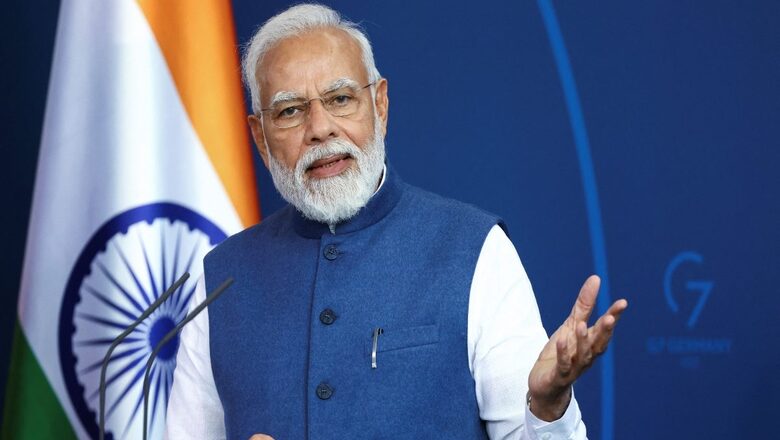
views
December 25 was designated as ‘Good Governance Day’ by Prime Minister Narendra Modi in 2014. The day has since become an occasion for the country to pay tribute to former Prime Minister Atal Bihari Vajpayee, while also appreciating the strides the nation is taking towards ensuring good governance. But what is the need of having a special day dedicated to good governance? Simply put, the Modi government’s goal was to popularise the notion of “good governance” among the masses, which would, in turn, help them appreciate the scale of transformation underway in India. The day is meant to foster awareness among citizens about government accountability and administration.
Nine years since, the Modi government has earned the reputation of ensuring last-mile delivery of welfare schemes and development to the people of India. At the same time, it has put in a lot of effort towards taking the government to the people, instead of the people struggling to find their way to authorities and the administration. This forms the bedrock of governance in India, today, and the digital medium is playing a critical role in the same.
One of the hallmarks of the Modi government is its ability to deliver good governance to the people of India in the remotest and most backward of regions. Since 2014, the government has been able to reach the people and ensure last-mile delivery of schemes despite considerable challenges. The JAM trinity, which has now metamorphosed into the ‘India Stack’, has played a crucial role in making government more accessible to people and reducing bureaucratic red tape.
A host of facilities are now offered on the digital medium, and governance itself makes use of dashboards, with no less than the PMO tracking development across the nation with such dashboards. The Centre, in fact, even assesses states’ performance under the good governance index.
India now boasts of a “world-class” digital public infrastructure. This has played an instrumental role in ensuring good governance, where people do not have to oscillate between government offices and return empty-handed at the end of the day. Today, Indians find the government at their fingertips, and much of that has been made possible by the country’s robust digital infrastructure.
Take for example the case of Free and Open-Source Software (FOSS), on top of which several governmental initiatives are reaching the people of India. It was in 2015 that the Centre decided to go big with open-source software, and announced a policy to encourage its use in government applications. As a result, services like Digilocker, Ayushman Bharat, Government e-Marketplace, Diksha, Aarogya Setu, and CoWIN, among others have all been built on open-source digital platforms. The role Aarogya Setu and CoWIN in particular played during the height of the Covid-19 pandemic tells us that we have come quite far as a nation in terms of digital public infrastructure.
Also Read: India’s Digital Revolution: From Financial Inclusion to Global Leadership in DPI
Today, the National eGovernance Plan has 31 Mission Mode projects. The government intends to make all government services available to the citizens of India via the digital medium. This is part of India’s pivot from physical and electronic governance to digital governance. UMANG, or the Unified Mobile Application for New-age Governance is a cornerstone of digital governance in today’s India. UMANG offers hundreds of services including payment, registration, information search, application forms and even public grievance redressal.
Today, every Indian state must mandatorily provide 56 crucial digital services to the citizens. Not all states are performing up to the mark in this aspect yet, and the implementation rate pan-India stands somewhere around 67 per cent, leaving more to be desired. The Centre must push laggard states to ensure that the 56 digital services are provided to citizens as soon as possible. That will only further help with both digital as well as good governance penetration across the country.
Ensuring Good Governance with a People-First Mindset
A nation is made of its people. Government, therefore, is of, and more importantly, for the people. That forms the foundational basis of the good governance push underway in India. And emerging technologies are playing a critical role in that push.
Artificial Intelligence has great potential to aid governance. Especially in terms of grievance redressal, the use of AI is being promoted by the Modi government in a big way. Not only does the use of AI help authorities identify individual grievances, but it goes a step further in helping the government map regional deficits in the implementation of schemes. It also helps in identifying and addressing local socio-economic issues.
One AI tool that has proven tremendously useful, and which Prime Minister Modi handles himself, is the Integrated Grievance Management System (IGMS) developed by the Department of Administrative Reforms and Public Grievances. This allows immediate categorisation of grievances which helps in directing them to the relevant departments. Furthermore, it can also conduct keyword and semantic searches, identify oversights, and present complaints in a real-time dashboard.
While emerging technologies have indeed played a crucial role in the drastic improvement of governance in India, it is often the smaller decisions that count most in a government being seen as humane. Public grievances have multiplied tenfold since 2014 to over 20 lakhs annually on the CPGRAMS portal. This is not because the volume of grievances is rising, but because the people of India now have a medium to express themselves and bring the government’s attention to issues they face.
The government’s work culture itself has changed, most noticeably at the Centre. Soon after taking office, Prime Minister Modi ended the colonial-era practise of attestation of documents by Gazetted Officers. Two years later, interviews were abolished for lower-grade posts in government, and merit became the sole criteria for selection.
Now the question is, what all constitutes governance? Remember, the Modi government has had to spend a considerable amount of time and resources in ensuring that the people have the very basics at their disposal. Whether it be toilets, tapped water connections, electricity connections, LPG cylinders or even pucca houses, the Centre, over the past nine years, has focused on delivering the most basic of amenities to people who need them the most. At the same time, financial inclusion and direct benefit transfers using the JAM trinity have worked wonders in making good governance visible to the people. All of this reinforces the perception that today, the people of India are at the centre of governance.
Good governance also involves the participation of citizens. To that end, PM Modi’s ‘NaMo’ app launched a survey last week to gauge the popular mood on a variety of issues, including people’s views about the performance of his government and their local MP. The ‘Jan Man Survey’ will help the government understand what the people feel about governance, and plug any gaps that exist, while also helping identify popular leaders in each constituency.
Today, there is a stark difference in how people interact with the government and administration. Instead of running between government offices, which had the reputation of not just being havens of corruption – but also of wasting citizens’ time – today, a host of government services are available on the internet. The government is reaching out to the people, instead of the people struggling to find their way to the government. Governance is earnestly reaching the grassroots now.
Views expressed in the above piece are personal and solely that of the author. They do not necessarily reflect News18’s views.



















Comments
0 comment